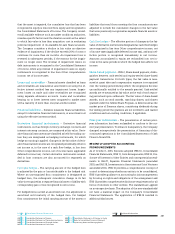Siemens 2014 Annual Report Download - page 261
Download and view the complete annual report
Please find page 261 of the 2014 Siemens annual report below. You can navigate through the pages in the report by either clicking on the pages listed below, or by using the keyword search tool below to find specific information within the annual report.
247 D. Consolidated Financial Statements 337 E. Additional Information
248 D. Consolidated Statements of Income
249 D. Consolidated Statements of Comprehensive Income
250 D. Consolidated Statements of Financial Position
251 D. Consolidated Statements of Cash Flows
252 D. Consolidated Statements of Changes in Equity
254 D. Notes to Consolidated Financial Statements
330 D. Supervisory Board and Managing Board
that the asset is impaired, the cumulative loss that has been
recognized in equity is removed from equity and recognized in
the Consolidated Statements of Income. The Company consid-
ers all available evidence such as market conditions and prices,
investee-specific factors and the duration as well as the extent
to which fair value is less than acquisition cost in evaluating
potential impairment of its available-for-sale financial assets.
The Company considers a decline in fair value as objective
evidence of impairment, if the decline exceeds % of costs or
continues for more than six months. An impairment loss is
reversed in subsequent periods, if the reasons for the impair-
ment no longer exist. The reversal of impairment losses on
debt instruments is recognized in the Consolidated Statement
of Income, while any reversal of impairment losses on equity
instruments is recognized in line item Other comprehensive
income, net of income taxes.
Loans and receivables – Financial assets classified as loans
and receivables are measured at amortized cost using the ef-
fective interest method less any impairment losses. Impair-
ment losses on trade and other receivables are recognized
using separate allowance accounts. Loans and receivables
bearing no or lower interest rates compared to market rates
with a maturity of more than one year are discounted.
Financial liabilities
– Siemens measures financial liabilities,
except for derivative financial instruments, at amortized cost
using the effective interest method.
Derivative financial instruments – Derivative financial
instruments, such as foreign currency exchange contracts and
interest rate swap contracts, are measured at fair value. Deriv-
ative financial instruments are classified as held for trading un-
less they are designated as hedging instruments, for which
hedge accounting is applied. Changes in the fair value of deriv-
ative financial instruments are recognized periodically either in
net income or, in the case of a cash flow hedge, in line item
Other comprehensive income, net of income taxes (applicable
deferred income tax). Certain derivative instruments embed-
ded in host contracts are also accounted for separately as
derivatives.
Fair value hedges – The carrying amount of the hedged item
is adjusted by the gain or loss attributable to the hedged risk.
Where an unrecognized firm commitment is designated as
hedged item, the subsequent cumulative change in its fair
value is recognized as a separate financial asset or liability with
corresponding gain or loss recognized in net income.
For hedged items carried at amortized cost, the adjustment is
amortized until maturity of the hedged item. For hedged
firm commitments the initial carrying amount of the assets or
liabilities that result from meeting the firm commitments are
adjusted to include the cumulative changes in the fair value
that were previously recognized as separate financial assets or
liabilities.
Cash flow hedges – The effective portion of changes in the fair
value of derivative instruments designated as cash flow hedges
are recognized in line item Other comprehensive income, net
of income taxes (applicable deferred income tax), and any inef-
fective portion is recognized immediately in net income.
Amounts accumulated in equity are reclassified into net in-
come in the same periods in which the hedged item affects net
income.
Share-based payment – IFRS , Share-based payment, distin-
guishes between cash-settled and equity-settled share-based
payment transactions. For both types, the fair value is mea-
sured at grant date and compensation expense is recognized
over the vesting period during which the employees become
unconditionally entitled to the awards granted. Cash-settled
awards are re-measured at fair value at the end of each report-
ing period and upon settlement. The fair value of share-based
awards, such as stock awards, matching shares, and shares
granted under the Jubilee Share Program, is determined as the
market price of Siemens shares, considering dividends during
the vesting period the grantees are not entitled to and market
conditions and non-vesting conditions, if applicable.
Prior-year information – The presentation of certain prior-
year information has been reclassified to conform to the cur-
rent year presentation. To enhance transparency, the Company
changed retrospectively the presentation of financing of dis-
continued operations in the Consolidated Statements of Cash
Flows in fiscal .
RECENTLY ADOPTED ACCOUNTING
PRONOUNCEMENTS
As of October , , Siemens adopted IFRS , Consolidated
Financial Statements, IFRS , Joint Arrangements, IFRS , Dis-
closure of Interests in Other Entities and consequential amend-
ments to IAS , Separate Financial Statements (amended
) and IAS , Investments in Associates and Joint Ventures
(amended ). IFRS provides a comprehensive concept of
control in determining whether an entity is to be consolidated,
IFRS provides guidance on accounting for joint arrangements
by focusing on rights and obligations of the arrangement and
IFRS provides comprehensive disclosure requirements for all
forms of interests in other entities. The standards are applied
on a retrospective basis. The adoption of the new standards did
not have a material impact on the Company’s Consolidated
Financial Statements. The application of IFRS resulted in
additional disclosures.
























